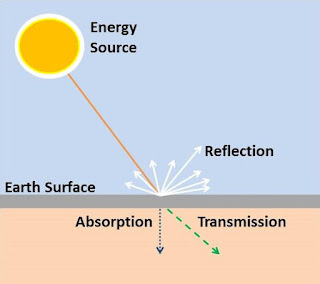In this article discuss the interaction of Electro-Magnetic Radiation (EMR) with earth surface features. After passing through atmosphere, the EMR reached to earth and as already discussed EMR which have least or almost no interaction with atmosphere is used by remote sensing sensors.
This part of spectrum is called atmospheric windows, which have zero or no interaction with atmosphere.
When EMR reached and interact with earth’s feature, three things take place with incident energy.
- Reflection
- Absorption
- Transmission
When EMR is incident on any earth feature then part of it, as shown in figure
- Reflected
- Absorbed
- Transmitted
Figure showing Interaction of sun energy (EMR) with Earth Surface Features
Estimated radiation states that sum of these energies (reflected, absorbed and transmitted) is equal to incidental energy on earth’s feature.
How much amount will be reflected or absorbed or transmitted depends upon material to material as well as many other conditions.
These quantities are sometimes expressed in non-dimensional way as
Transmittance–
This is defined as radiation which penetrates into certain surface materials such as water with some fraction (up to 100%) of the incident radiation.
It depends on material property, if the material is more transparent and thin than there will be more transmittance.
Absorptance–
It take place when incident energy is absorbed by molecular reactions, Sometimes portion of this incident energy is then re-radiated and some of it remains there and heats the objected target.
Reflectance–
It is also defined as re-radiation from earth’s features. Most of the radiations are reflected and scattered from the target at various angles.
It is depend upon the property of feature such as surface roughness and also the incidence angle of the EMR.
This reflectance is very important in this process as it is received and recorded by satellite sensor.
It helps to differentiate materials based on reflectance received for different elements on earth surface. It may possible that same material/object have different reflectance value with change in wavelength.
Therefore, it can be concluded that features with same reflectance in one wavelength, may have different reflectance values in some other wavelength and it helps to distinguish object with change in wavelength.
As it is understood that reflectance from earth’s feature is key parameter in remote sensing process, because it is sensed by sensor. Surface property of object will become very important in reflectance process.
Various types of surface reflect EMR in different ways some are Perfect Specular Reflector, Near-Perfect Specular Reflector, Perfect Diffuse Reflector and Near-Perfect Diffuse Reflector.
Earth Surface Features Properties
There are basically three type of surface or natural surface cover on the earth
- Vegetation
- Soil
- Water
So reflectance will take place based on the properties of these natural land cover.
Vegetation-
There is a drop in reflectance value in the visible spectrum due to chlorophyll, as it is absorbs strongly in and around 0.45 mm and 0.67 mm wavelength. This is also called as chlorophyll absorption bands.
If any plant is not healthy in that case the absorption would be less and reflectance will be more.
In near IR, reflectance increases dramatically and reached nearly about to 40-50% and most of the remaining part is transmitted.
Water –
Most of the incident energy will be absorbed by water and there will be less or no reflectance received by sensor. Maximum reflectance reaches to hardly 10% in case of water and also only in visible part of spectrum.
Soil-
In case of soil, reflectance will be more as compared to others. But reflectance depends upon various factor or properties such as Moisture content as it decreases reflectance.
Soil texture– coarse texture soil will have lower moisture content & higher reflectance Surface roughness
Presence of organic matter content in soil as it also decreases reflectance
The ultimate reflectance of object is received by sensor and converts this reflectance to form an image.

It is a proficient article that you have shared here about Magnetic. I got some unique and valuable information from your article. Thankful to you for sharing this article here.
diametric magnets
You've shared some excellent information about Magnetic. I'm happy I came across this post because it contains a lot of useful information. Thank you for sharing this story.
Amorphous Magnetic Cores online in USA
Thanks for sharing, if you want more benefits then remain connect with us.
Reflector Crack
The post you've shared here is basically informative because it contains some best knowledge which is extremely essential on behalf of me for Ferrite Cores for sale online in USA . Thanks for posting it. Keep it up.
Really Appreciable Article, Honestly Said The Thing Actually I liked The most is the step-by-step explanation of everything needed to be known for a blogger or webmaster to comment, I am going show this to my other blogger friends too.
reflector-pro-crack